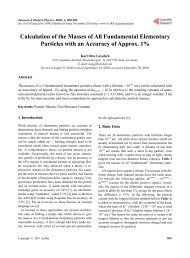Encoding multiple unnatural amino acids via evolution of a ...
Encoding multiple unnatural amino acids via evolution of a ...
Encoding multiple unnatural amino acids via evolution of a ...
You also want an ePaper? Increase the reach of your titles
YUMPU automatically turns print PDFs into web optimized ePapers that Google loves.
LETTERS NATURE |Vol 464 | 18 March 2010<br />
on the nanometre scale. Unlike existing protein cyclization methods for<br />
recombinant proteins 26,27 , these cross-links can be encoded at any spatially<br />
compatible sites in a protein, not just placed at the termini. In<br />
contrast to the chemically diverse cyclization methods that can be<br />
accessed with peptides by solid-phase peptide synthesis 28 , these crosslinks<br />
can be encoded into proteins <strong>of</strong> essentially any size. Given the<br />
importance <strong>of</strong> disulphide bonds in natural therapeutic proteins and<br />
hormones, the utility <strong>of</strong> peptide stapling strategies 29 , the importance <strong>of</strong><br />
peptide cyclization 30 , and the improved stability <strong>of</strong> proteins cyclized by<br />
native chemical ligation 26 , it will be interesting to investigate the<br />
enhancement <strong>of</strong> protein function that may be accessed by combining<br />
the encoding <strong>of</strong> these cross-links with directed <strong>evolution</strong> methods. By<br />
combining the numerous variant MjTyrRS–tRNACUA and MbPylRS–<br />
tRNACUA pairs reported for the incorporation <strong>of</strong> <strong>unnatural</strong> <strong>amino</strong><br />
<strong>acids</strong> 1,6,7 (after appropriate anticodon conversion using the steps<br />
reported here) with ribo-Q1, it will be possible to encode more than<br />
200 <strong>amino</strong> acid combinations in recombinant proteins.<br />
METHODS SUMMARY<br />
Methods for cloning, site-directed mutagenesis and library construction are<br />
described in the Supplementary Materials. Ribosome libraries were screened<br />
for quadruplet suppressors using a modification <strong>of</strong> the strategy to discover<br />
ribo-X 9 .<br />
E. coli genehogs or DH10B were used in all protein expression experiments<br />
using LB medium supplemented with appropriate antibiotics and <strong>unnatural</strong><br />
<strong>amino</strong> <strong>acids</strong>. Proteins were purified by affinity chromatography using published<br />
standard protocols.<br />
Translational fidelity <strong>of</strong> evolved O-ribosomes was measured by misincorporation<br />
<strong>of</strong> 35 S-labelled cysteine 9 . In brief, GST–MBP was produced by<br />
the O-ribosome in the presence <strong>of</strong> 35 S-cysteine. The protein was purified, cleaved<br />
with thrombin, which cleaves the linker between GST and MBP, and analysed by<br />
SDS–PAGE and phospho-imaging. A modified dual-luciferase assay was used to<br />
measure the fidelity <strong>of</strong> translation <strong>of</strong> O-ribosomes 9 . Luminescence from a luciferase<br />
mutant containing an inactivating missense mutation in this assay is a<br />
measure <strong>of</strong> translational inaccuracy <strong>of</strong> the ribosome. The dual luciferase reporter<br />
system was translated by the O-ribosome, extracted in the cold and luciferase<br />
activity measured using the Dual-Luciferase Reporter Assay System (Promega).<br />
Liquid chromatography (LC)–MS/MS <strong>of</strong> proteins was performed by NextGen<br />
Science. Proteins were excised from Coomassie-stained SDS–PAGE gels,<br />
digested with trypsin and analysed by LC–MS/MS. Total protein mass was<br />
obtained by electrospray ionization (ESI)-MS; purified protein was dialysed into<br />
10 mM ammonium bicarbonate, pH 7.5, mixed 1:1 with 1% formic acid in 50%<br />
methanol, and total mass was determined in positive ion mode.<br />
Cyclization reactions were performed for 5 min at room temperature on purified<br />
protein in 50 mM sodium phosphate, pH 8.3, in the presence <strong>of</strong> 1 mM ascorbic acid,<br />
1mMCuSO4 and 2 mM bathophenathroline. Details <strong>of</strong> all methods can be found in<br />
the Supplementary Materials.<br />
Received 26 June 2009; accepted 7 January 2010.<br />
Published online 14 February 2010.<br />
1. Xie, J. & Schultz, P. G. A chemical toolkit for proteins–an expanded genetic code.<br />
Nature Rev. Mol. Cell Biol. 7, 775–782 (2006).<br />
2. Steer, B. A. & Schimmel, P. Major anticodon-binding region missing from an<br />
archaebacterial tRNA synthetase. J. Biol. Chem. 274, 35601–35606 (1999).<br />
3. Chin, J. W., Martin, A. B., King, D. S., Wang, L. & Schultz, P. G. Addition <strong>of</strong> a<br />
photocrosslinking <strong>amino</strong> acid to the genetic code <strong>of</strong> Escherichia coli. Proc. Natl<br />
Acad. Sci. USA 99, 11020–11024 (2002).<br />
4. Srinivasan, G., James, C. M. & Krzycki, J. A. Pyrrolysine encoded by UAG in Archaea:<br />
charging <strong>of</strong> a UAG-decoding specialized tRNA. Science 296, 1459–1462 (2002).<br />
5. Polycarpo, C. et al. An <strong>amino</strong>acyl-tRNA synthetase that specifically activates<br />
pyrrolysine. Proc. Natl Acad. Sci. USA 101, 12450–12454 (2004).<br />
6. Neumann, H., Peak-Chew, S. Y. & Chin, J. W. Genetically encoding N e -acetyllysine<br />
in recombinant proteins. Nature Chem. Biol. 4, 232–234 (2008).<br />
7. Nguyen, D. P. et al. Genetic encoding and labeling <strong>of</strong> aliphatic azides and alkynes<br />
in recombinant proteins <strong>via</strong> a pyrrolysyl-tRNA synthetase/tRNA(CUA) pair and<br />
click chemistry. J. Am. Chem. Soc. 131, 8720–8721 (2009).<br />
8. Rackham, O. & Chin, J. W. A network <strong>of</strong> orthogonal ribosome?mRNA pairs. Nature<br />
Chem. Biol. 1, 159–166 (2005).<br />
9. Wang, K., Neumann, H., Peak-Chew, S. Y. & Chin, J. W. Evolved orthogonal<br />
ribosomes enhance the efficiency <strong>of</strong> synthetic genetic code expansion. Nature<br />
Biotechnol. 25, 770–777 (2007).<br />
444<br />
©2010<br />
Macmillan Publishers Limited. All rights reserved<br />
10. Rostovtsev, V. V., Green, L. G., Fokin, V. V. & Sharpless, K. B. A stepwise huisgen<br />
cycloaddition process: copper(I)-catalyzed regioselective ‘‘ligation’’ <strong>of</strong> azides and<br />
terminal alkynes. Angew. Chem. Int. Edn Engl. 41, 2596–2599 (2002).<br />
11. Hohsaka, T. & Sisido, M. Incorporation <strong>of</strong> non-natural <strong>amino</strong> <strong>acids</strong> into proteins.<br />
Curr. Opin. Chem. Biol. 6, 809–815 (2002).<br />
12. Ohtsuki, T., Manabe, T. & Sisido, M. Multiple incorporation <strong>of</strong> non-natural <strong>amino</strong><br />
<strong>acids</strong> into a single protein using tRNAs with non-standard structures. FEBS Lett.<br />
579, 6769–6774 (2005).<br />
13. Murakami, H., Hohsaka, T., Ashizuka, Y. & Sisido, M. Site-directed incorporation<br />
<strong>of</strong> p-nitrophenylalanine into streptavidin and site-to-site photoinduced electron<br />
transfer from a pyrenyl group to a nitrophenyl group on the protein framework.<br />
J. Am. Chem. Soc. 120, 7520–7529 (1998).<br />
14. Rodriguez, E. A., Lester, H. A. & Dougherty, D. A. In vivo incorporation <strong>of</strong> <strong>multiple</strong><br />
<strong>unnatural</strong> <strong>amino</strong> <strong>acids</strong> through nonsense and frameshift suppression. Proc. Natl<br />
Acad. Sci. USA 103, 8650–8655 (2006).<br />
15. Monahan, S. L., Lester, H. A. & Dougherty, D. A. Site-specific incorporation <strong>of</strong><br />
<strong>unnatural</strong> <strong>amino</strong> <strong>acids</strong> into receptors expressed in mammalian cells. Chem. Biol.<br />
10, 573–580 (2003).<br />
16. Anderson, J. C. et al. An expanded genetic code with a functional quadruplet<br />
codon. Proc. Natl Acad. Sci. USA 101, 7566–7571 (2004).<br />
17. Atkins, J. F. & Bjork, G. R. A gripping tale <strong>of</strong> ribosomal frameshifting: extragenic<br />
suppressors <strong>of</strong> frameshift mutations spotlight P-site realignment. Microbiol. Mol.<br />
Biol. Rev. 73, 178–210 (2009).<br />
18. Stahl, G., McCarty, G. P. & Farabaugh, P. J. Ribosome structure: revisiting the<br />
connection between translational accuracy and unconventional decoding. Trends<br />
Biochem. Sci. 27, 178–183 (2002).<br />
19. Selmer, M. et al. Structure <strong>of</strong> the 70S ribosome complexed with mRNA and tRNA.<br />
Science 313, 1935–1942 (2006).<br />
20. Magliery, T. J., Anderson, J. C. & Schultz, P. G. Expanding the genetic code:<br />
selection <strong>of</strong> efficient suppressors <strong>of</strong> four-base codons and identification <strong>of</strong><br />
‘‘shifty’’ four-base codons with a library approach in Escherichia coli. J. Mol. Biol.<br />
307, 755–769 (2001).<br />
21. Khazaie, K., Buchanan, J. H. & Rosenberger, R. F. The accuracy <strong>of</strong> Qb RNA<br />
translation. 1. Errors during the synthesis <strong>of</strong> Qb proteins by intact Escherichia coli<br />
cells. Eur. J. Biochem. 144, 485–489 (1984).<br />
22. Laughrea, M., Latulippe, J., Filion, A. M. & Boulet, L. Mistranslation in twelve<br />
Escherichia coli ribosomal proteins. Cysteine misincorporation at neutral <strong>amino</strong><br />
acid residues other than tryptophan. Eur. J. Biochem. 169, 59–64 (1987).<br />
23. Kramer, E. B. & Farabaugh, P. J. The frequency <strong>of</strong> translational misreading errors in<br />
E. coli is largely determined by tRNA competition. RNA 13, 87–96 (2007).<br />
24. Chin, J. W. et al. Addition <strong>of</strong> p-azido-L-phenylalanine to the genetic code <strong>of</strong><br />
Escherichia coli. J. Am. Chem. Soc. 124, 9026–9027 (2002).<br />
25. Mukai, T. et al. Adding L-lysine derivatives to the genetic code <strong>of</strong> mammalian cells<br />
with engineered pyrrolysyl-tRNA synthetases. Biochem. Biophys. Res. Commun.<br />
371, 818–822 (2008).<br />
26. Camarero, J. A., Pavel, J. & Muir, T. W. Chemical synthesis <strong>of</strong> a circular protein<br />
domain: evidence for folding-assisted cyclization. Angew. Chem. Int. Ed. 37,<br />
347–349 (1998).<br />
27. Scott, C. P., Abel-Santos, E., Wall, M., Wahnon, D. C. & Benkovic, S. J. Production<br />
<strong>of</strong> cyclic peptides and proteins in vivo. Proc. Natl Acad. Sci. USA 96, 13638–13643<br />
(1999).<br />
28. Li, P. & Roller, P. P. Cyclization strategies in peptide derived drug design. Curr. Top.<br />
Med. Chem. 2, 325–341 (2002).<br />
29. Walensky, L. D. et al. Activation <strong>of</strong> apoptosis in vivo by a hydrocarbon-stapled BH3<br />
helix. Science 305, 1466–1470 (2004).<br />
30. Trauger, J. W., Kohli, R. M., Mootz, H. D., Marahiel, M. A. & Walsh, C. T. Peptide<br />
cyclization catalysed by the thioesterase domain <strong>of</strong> tyrocidine synthetase. Nature<br />
407, 215–218 (2000).<br />
Supplementary Information is linked to the online version <strong>of</strong> the paper at<br />
www.nature.com/nature.<br />
Acknowledgements We are grateful to P. B. Kapadnis for synthesizing CAK and to<br />
W. An for assistance with some experiments. J.W.C. is grateful to the ERC and the<br />
MRC for funding. K.W. is grateful to Trinity College, Cambridge for a fellowship.<br />
Author Contributions K.W., H.N., L.D. and J.W.C. planned the experiments. K.W.<br />
selected and characterized ribo-Q, with help from L.D. K.W. and L.D. characterized<br />
amber and quadruplet incorporation by protein expression and mass<br />
spectrometry. L.D. and M.G.-A. performed protein expression experiments. H.N.<br />
demonstrated the mutual orthogonality <strong>of</strong> synthetase tRNA pairs, evolved<br />
synthetases, and characterized the double incorporation and protein cyclization,<br />
with help from M.G.-A. H.N., K.W., L.D. and J.W.C. analysed the data and wrote the<br />
paper.<br />
Author Information Reprints and permissions information is available at<br />
www.nature.com/reprints. The authors declare no competing financial interests.<br />
Correspondence and requests for materials should be addressed to J.W.C.<br />
(chin@mrc-lmb.cam.ac.uk).



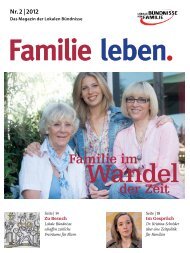
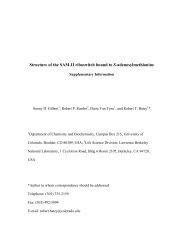
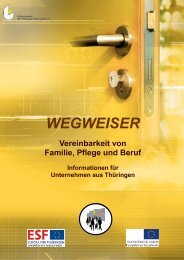
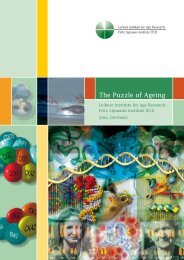

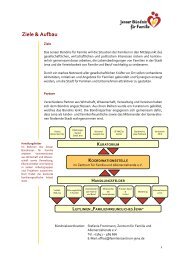



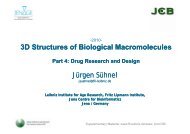
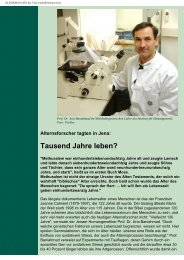

![Programm [pdf]](https://img.yumpu.com/20944039/1/184x260/programm-pdf.jpg?quality=85)
